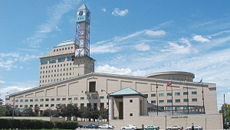A publication under permanent construction
by Jean-Pierre Chupin, published 2006-05-01

Devoted to the archiving, analysis and history of contemporary architecture, the Canadian Competitions Catalogue is an interactive publication under permanent construction, in regards to both its contents and its consultation. Developed with the initiative of the Laboratoire d'étude de l'architecture potentielle, in order to render public an essential portion of its documentary database, it currently provides access to more that 4000 reproductions of documents of architecture, landscape architecture and urbanism. The CCC is one of the few data bases and research engines entirely devoted to competitions. (See "competition worldwide" to get access to websites in over 25 countries).
Each of the competitions documented in the Canadian Competitions Catalogue generated tens, and at times hundreds of projects. For example, The Mississauga City Hall Competition in 1981 produced nearly 250 projects; or closer to home, the competition held for the design of the Châteauguay Library in 2001 received approximately 60 proposals during its first stage; and finally, that of the Montréal Symphony Orchestra (OSM) in 2002 generated over 100 preliminary designs from architects worldwide.
Projects developed during architectural competitions represent a particularly unknown and neglected architectural heritage. These projects however, have a value well beyond their possible success in the competition. We can all identify many non-winning projects - truly "potential architecture", which continues to influence the practice and transfer of ideas, in ways that are often more influential than built projects themselves. By definition, the competition environment is rich in critical, reflective, innovative and bold proposals.
Thanks to the generosity of many architectural offices who graciously opened their professional archives to academic research and to a significant financial support from several sponsoring organizations, beginning in 2002 the Laboratoire d'étude de l'architecture potentielle de l'Université de Montréal (L.E.A.P.) team has been assembling information and documents pertaining to architectural, urban planning and landscape architectural competitions organized in Canada since 1945. Founded on the possibilities of comparative procedures, this long-term research project, of which the scientific, cultural, pedagogical and technological impacts are extensive, will also permit to better understand the phenomenon of competitions as well as the relationship between architectural practice and the various modes of cultural mediation. Competition projects offer a reflection on spatial and societal organization; they should also permit an enlightened and detailed comprehension of our cultural history.
Up to now, more than 30 competitions organized in Quebec have been documented and only a dozen from other provinces. In the nearest future, the Laboratoire d'Étude de l'Architecture Potentielle will build a research network within the 10 canadian schools of architecture in order to progressively ensure the most complete constitution of the CCC.
Each of the competitions documented in the Canadian Competitions Catalogue generated tens, and at times hundreds of projects. For example, The Mississauga City Hall Competition in 1981 produced nearly 250 projects; or closer to home, the competition held for the design of the Châteauguay Library in 2001 received approximately 60 proposals during its first stage; and finally, that of the Montréal Symphony Orchestra (OSM) in 2002 generated over 100 preliminary designs from architects worldwide.
Projects developed during architectural competitions represent a particularly unknown and neglected architectural heritage. These projects however, have a value well beyond their possible success in the competition. We can all identify many non-winning projects - truly "potential architecture", which continues to influence the practice and transfer of ideas, in ways that are often more influential than built projects themselves. By definition, the competition environment is rich in critical, reflective, innovative and bold proposals.
Thanks to the generosity of many architectural offices who graciously opened their professional archives to academic research and to a significant financial support from several sponsoring organizations, beginning in 2002 the Laboratoire d'étude de l'architecture potentielle de l'Université de Montréal (L.E.A.P.) team has been assembling information and documents pertaining to architectural, urban planning and landscape architectural competitions organized in Canada since 1945. Founded on the possibilities of comparative procedures, this long-term research project, of which the scientific, cultural, pedagogical and technological impacts are extensive, will also permit to better understand the phenomenon of competitions as well as the relationship between architectural practice and the various modes of cultural mediation. Competition projects offer a reflection on spatial and societal organization; they should also permit an enlightened and detailed comprehension of our cultural history.
Up to now, more than 30 competitions organized in Quebec have been documented and only a dozen from other provinces. In the nearest future, the Laboratoire d'Étude de l'Architecture Potentielle will build a research network within the 10 canadian schools of architecture in order to progressively ensure the most complete constitution of the CCC.














